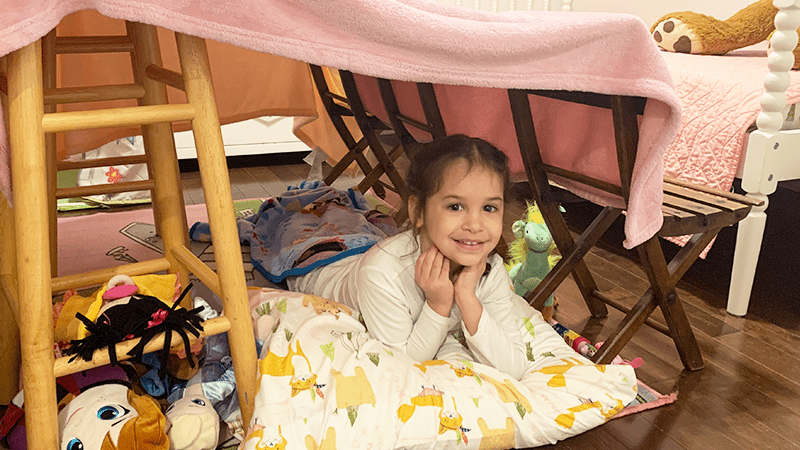Now’s a Good Time to Teach Your Kids to Play on Their Own
Independent play is a skill your kids will use for the rest of their lives — and a way to claim some time for yourself during quarantine.

By Kate Rope
“When I was a kid, there was lots and lots of free play with no parental interaction. My kids cannot be alone for five minutes. WHERE DID WE GO WRONG?”
That post was just one of many desperate pleas that came across my Facebook feed as parents in coronavirus quarantines vented online. Parents are trying to work from home while home schooling kids who came up in the era of planned play dates, packed schedules and screen time. This is new territory for many of us.
“We’re not bad parents because we give our kids tech and routine and we work,” said Meghan Leahy, a parent coach and author of “Parenting Outside the Lines.” And now, when all of those routines have been upended, we’re doing the best we can with what we’ve got. Research has shown that our heavily scheduled lives have contributed to a significant decrease in the amount of free time kids have, so their independent play skills may not be ready for the moment we are facing.
That’s OK. With a few tools, experts say, we can teach our kids how to play more independently, which will reward them with lifelong benefits. “Independent play encourages time management, executive function and organizational skills, and emotional and physical awareness and regulation,” said Dana Rosenbloom, a parent and child educator in Manhattan. “All skills that help us be successful individuals as adults.” And, in the process, we can make our lives right now just a bit easier. “Our kids aren’t broken,” said Leahy, “but this can also be a nice time to tell them, ‘You have parts of your brain you’ve never used, and we can get there.’”
Here’s how.
Start with connection.
“In this time of anxiety and uncertainty, it’s really natural for children to regress, which means their dependency needs” — for comfort, physical closeness, affection and communication — “are going to be paramount,” said Lawrence J. Cohen, Ph.D., author of “Playful Parenting.” “It’s a bit of a paradox, but independence and exploration are not the opposite of dependence, safety and security. They flow from them.”
If you want your kids to feel confident enough to play on their own, Dr. Cohen said, “start the day with some really high-quality connected play. Set a timer for 20 minutes, put away your phone and say to your children, ‘I’ve got 20 minutes just for you. What would you like to do?’” And then, put yourself “at their service as a helper and a follower,” he recommended. “Don’t tell them what they should do.”
But you can encourage them. “Describe and comment on what they’re doing with no judgment,” recommended Laura Markham, Ph.D., founding editor of the online parenting resource, Aha! Parenting. “It might be a little bit boring for you, but your child’s takeaway will be, ‘Wow, my mom or dad likes to watch me play, I’m good at this.’” When the timer goes off, tell your kids, “I loved watching you play, and I can again later.” Give them a hug and go take care of your stuff. “Usually they will keep playing,” said Dr. Markham.
And start small.
“For a kid who doesn’t play at all by themselves, an hour is an eternity,” said Catherine Pearlman, Ph.D., author of “Ignore It!” “Start with five or 10 minutes and grow from there.” She also recommends offering to do something with them that they really enjoy afterward.
Create invitations to play.
There is a concept popular in the world of “unschooling” (a home education approach that allows children’s interests to drive learning) called “strewing”: creating prompts for play time that children discover on their own. “It’s one of the best tricks of the trade,” said Avital Schreiber-Levy, a parenting performance coach in New Jersey who has created a play guide for parents on lockdown. You put “spotlights” on toys or other objects by setting them up in an unexpected way, and then let your kids stumble upon them.
For example, create a vignette on a cookie sheet — such as a few dolls having a tea party or a group of trucks with little piles of dried beans. Sort Legos into piles by color or build half a structure. Put out a puzzle with all the pieces flipped over and ready to go.

Schreiber-Levy also recommends moving toys in and out of rotation. “When toys sit out too long, they go stale,” she said. “It’s about making them novel again, either because we take them away or we set them up in a new way.”
Make room for mess.
“Messy or tactile play — with paint, sand, clay, beads or water — is something many parents avoid, because it’s inconvenient,” Schreiber-Levy said. But, for kids, it’s “really soothing and will keep them engaged for a long time.” One way to contain the mess is to designate a space for it. The outdoors is the obvious choice, but you can also make a space inside with buckets, large trays and towels. Schreiber-Levy said her 2- and 4-year-old will play in the bathtub with shaving cream for an hour and a half, so she sets up shop with her computer on the toilet while they have at it.
Build a movement zone.
“Kids are not going to sleep or behave well unless they have exhausted their body,” Schreiber-Levy said. Outside activities are great, but you can also create a safe space inside for them to tumble. Clear away furniture and then pile in soft things — pillows, cushions, yoga mats, sleeping bags. With any luck the kids will end up making a fort that keeps them entertained for hours.
Build connection into play.
“Often when parents present independent play, it’s like slamming a door on the child’s face and saying, ‘Go play outside,’” Dr. Cohen said. Instead, challenge your kids to do activities you can participate in later, like creating a piece of art for you, coming up with a surprise for another adult in the home, or building an obstacle course in the living room using cushions and chairs. “Say to them, ‘When you’ve figured it out, come show me and I’ll time you,’” Dr. Cohen recommended. “Then it’s still about connection, even though they are playing independently.”
Customize your plan for your kid.
While independent play is a “teachable skill,” Rosenbloom said, she noted that it will look different for different kids, depending on their age, as well as their developmental age.
For children with A.D.H.D. or executive functioning skills that are developing more slowly, Rosenbloom recommended using dry erase boards to help them plan out their time. “One of the greatest strengths of many people with A.D.H.D. is that they can get hyper-focused on things they love and stay engaged for a long period of time,” said Rosenbloom. Choose those things for play time. “They are going to be independent for a longer period of time if we have set them up appropriately,” she said.
And don’t compare your kids to others. “Don’t look over your fence at what your neighbors are doing,” Leahy said. “Don’t look at Instagram. If you have a neurodiverse family, don’t go to the neurotypical families and compare. Play your own game and reach out to your communities.”
Be patient.
“If your kids are in school all day or on a screen all day, they need to stretch their independent play muscle that may have atrophied,” said Schreiber-Levy. “We want everything to happen instantaneously,” Rosenbloom said. But, if we can understand that this is a transition for all of us and have patience with the process, she added, it will work.
And this will not only help parents get work done, it will also help reassure your child in this scary time. “Play is therapy for kids,” Schreiber-Levy said. “If kids get to construct their own worlds and inhabit them, they play out themes that are troubling them. They get to seize control and emotionally process what is going on.” That’s something we all need right now.




